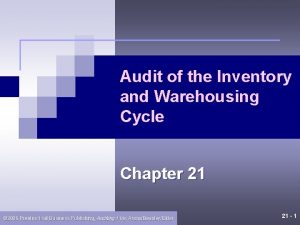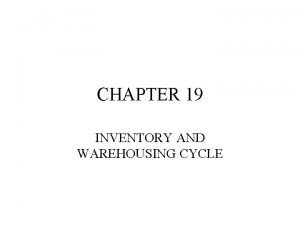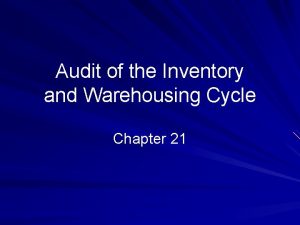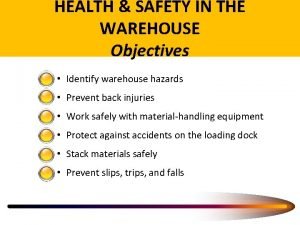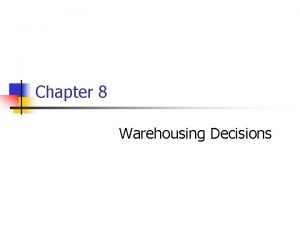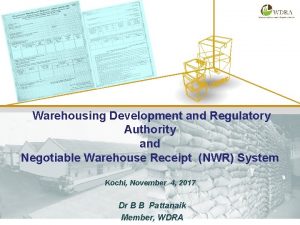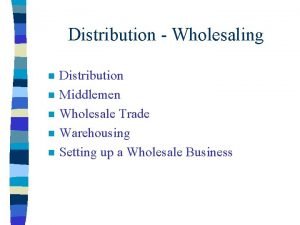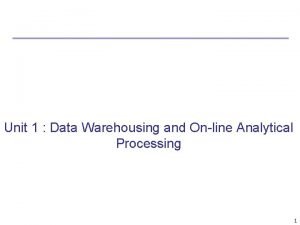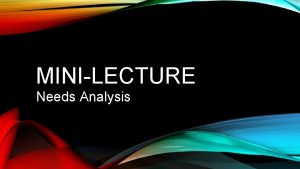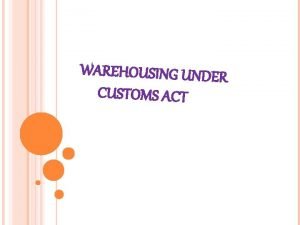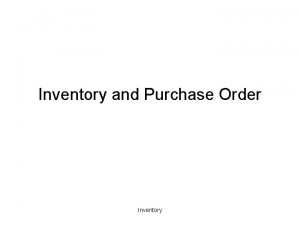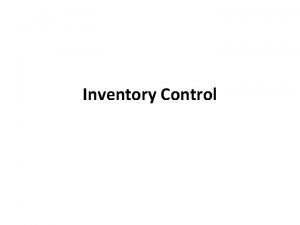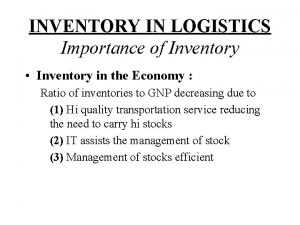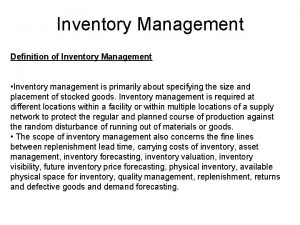Inventory and Warehousing MiniLecture Process and Testing 1















- Slides: 15

Inventory and Warehousing Mini-Lecture Process and Testing 1

Inventory may be the largest account on the balance sheet and has is related to other operational processes and results. This process is inherently risky with a higher risk of fraud. Physical control and counting of inventory is often difficult. This process requires estimation of the value of inventory. 1. Inventory and Warehousing Overview 2

What are the Inventory/Warehousing Process Objectives Determine what to sell Determine whether/how to make/buy it Determine how much to make or buy (sales forecasting) Determine when to make or buy it (production schedule/MRP) Receive goods required to complete orders on a timely basis Minimize product quality issues/returns Minimize inventory transaction costs Control movements of inventory to different locations Deliver goods and services on a timely basis Minimize theft of inventory Maximize inventory turnover Minimize slow-moving, obsolescence, scrap Capture and effectively use costing information Capture, process, and report information necessary for process improvement 1. 1 Inventory and Warehousing Process Objectives 3

How are Inventory/Warehousing Objectives Accomplished (By Who)? Major functions Managing the materials master file (cost accounting/IT) Planning and controlling inventories used in production (prod scheduler/MRP) Requisitioning raw materials via purchasing (prod) and keeping custody (whse) Issuing raw materials to manufacturing (production) Following materials through production (production) Keeping custody and issuing finished goods to sales (warehousing) Maintaining inventory costs and records (cost accounting) Accumulating costs, properly classifying in general ledger (accounting) Accuracy/valuation of inventory (accounting) 1. 2 Inventory and Warehousing Activities 4

How do these process activities impact inventory accounting records? Routine transactions (e. g. , purchases, inventory movements, sales) Non-routine transactions (e. g. , inventory returns, inventory costing) Accounting estimates (e. g. , inventory reserve, valuation of inventory, warranty claims) Key Accounting Transactions Purchases – purchase order, receiving document, purchase invoice, purchase journal Sales—sales order, shipping document, sales invoice, sale journal Purchase returns – debit memo, inventory ticket Sales returns—credit memo, inventory ticket Inventory estimation— perpetual inventory master, inventory “aging” schedule Inventory write offs—write off authorization 1. 3 Inventory Accounting 5

How do these process activities impact inventory accounting records? When do we record inventory Inventory on receipt of goods (generally) but depends on shipping terms Goods in transit – if we bear the risk of loss we must accrue for goods in transit Goods received, not invoiced = accrued Invoices received but not matched to goods/services = not accrued w/o receiver How do we cost inventory Purchased inventory – LIFO, FIFO, weighted average cost + freight, storage, etc. Manufactured inventory – Purchased inventory + direct labor and mfg overhead 1. 3 Inventory Accounting When do we recognize COGS Match with revenue – when we sell we recognize associated costs How do we value inventory (net realizable value) Lower of historical cost or market (cost to replace or selling price) Write-downs for obsolescence, slow-moving, damaged goods Other accounts affected – AP, payroll, sales/AR 6

What are auditors concerned about when they design tests of Inventory/Warehousing? Recorded inventory transactions occurred Recorded inventory exists All inventory is included in the accounts (complete) Inventory costs are accurate Inventory is properly classified Inventory cut-off period is correct Inventory is valued at realizable value The client has rights to inventory Inventory presentation and disclosures are proper 1. 4 Inventory and Warehousing Audit Objectives 7

What tests of controls do auditors perform over the inventory/warehousing process? Existence/occurrence (main)- all recorded inventory exists (not overstated) Control Activities: Segregating duties, prenumbered documents, physical safeguards Tests of Controls: How inventory moves between departments, physical inventory Accuracy/Valuation – inventory recorded at proper amount (not over/under stated) Control Activities: Documents/records, Reconciliations and independent review Tests of controls: How costs are determined and accumulated, Identification of obsolete/slow-moving/excess, physical inventory procedures Completeness – all inventory received is recorded (not understated) Control Activities: Prenumbered documents, 3 -way match (p. o. , receiver, invoice) Tests of Controls: How documents are controlled/authorized, tracing samples to receiving reports and to purchases journal 1. 5 Inventory and Warehousing Control Testing 8

What concerns might auditors have about accounting for inventory/warehousing? Nature of Business Intense industry competition, changes in technology and innovation Products required to maintain, difficult to forecast - spare parts inventories Nature of Product Small but high value products, subject to theft (diamonds, electronics) Highly customized product – effective forecasting/order fulfilment Products difficult to measure - liquids, chemicals, etc Products difficult to value – diamonds, real estate, etc. Nature of Control Inventory in different locations, 3 rd party contracts Highly manual processes/controls Subject to theft Physical control/count is complicated (remote environment? ) 1. 6 Inventory and Warehousing Concerns 9

When outside firms of nonaccountants specializing in the taking of physical inventories are used to count, list, price and subsequently compute the total dollar amount of inventory on hand at the date of the physical count, the auditor would ordinarily A. Consider the report of the outside inventory taking firm to be an acceptable alternative procedure to the observation of physical inventories. B. Make or observe some physical counts of the inventory, recompute certain inventory calculations, and test certain inventory transactions. C. Not reduce the extent of work on the physical count of inventory. D. Consider the reduced audit effort with respect to the physical count of inventory as a scope limitation. 1. 6 Q Inventory and Warehousing Concerns 10

What are the primary substantive tests that auditors perform on sales and receivables related accounts? Substantive analytical procedures Physical observation of inventory (required audit procedure since 1938) Review inventory master and GL (detail tie-out) Inventory price and compilation tests (unit prices are correct, recalculate price * qty) Inventory valuation review 2 Substantive Testing Inventory 11

What common analytical procedures do auditors perform on sales and receivables related accounts? Compare by product line Gross margin percentage with previous years Inventory by month over time Unit costs of inventory with previous years Compare with previous years Gross margin percentages Unit costs of inventory Manufacturing costs (variable and fixed) Extended inventory value (qty * price) Inventory turnover/days inventory on hand Inventory category as a percentage of total inventory Compare with previous years Inventory reserve as a percentage of inventory accounts (and by inventory classification) Inventory write-offs as a percentage of total inventory 2. 1 Substantive Analytical Procedures 12

How do auditors test inventory through physical count and observation? Make inquiries about procedures What – raw goods, finished goods, everything in between Where – on-site, off-site, in-transit Understand controls over count How – 3 Ts (tag, test, tally) Instructions/supervision, count verifications, tag control Observe counting procedures Auditors perform independent counts Sampling method versus 100% count Reconciliation of book to physical inventory 2. 2 Physical Inventory Observation 13

What other types of procedures do auditors perform on inventory related accounts? Review inventory master and GL (detail tie-out) Inventory reconciliation, footing and tracing totals to the GL Classification of inventory into raw, WIP and FG Inventory price and compilation tests (unit prices are correct, recalculate price * qty) Trace units and unit costs of raw materials to inventory master files and totals to cost accounting Test roll-up of finished goods costing to inventory master and totals to cost accounting Inventory valuation review Review of variance reports – material, labor and overhead standards compared to actual Lower of cost or market review – we only write down in US GAAP, we don’t write up Review of inventory “aging” / status– obsolete, slow-moving, damaged, scrap 2. 3 Other Tests of Details 14

How do auditors test the inventory reserve? Gain understanding of financial reporting framework How does management make accounting estimates Method, assumptions, change from prior period, assessing estimation uncertainty Review effectiveness of controls over inventory reserves Completeness, relevance accuracy of data used Review and approval of estimates, inputs/assumptions Remuneration of mgmt responsible for estimate not directly tied to estimate Specialist or service organization provides estimate or data supporting estimate Substantive audit procedures Test how management determined estimate (method of measurement, assumptions/data) Develop point estimate or range – independent or based on management assumptions Do subsequent events support estimate 2. 4 Substantive Tests of Inventory (Valuation) 15
 Inventory and warehousing cycle
Inventory and warehousing cycle Inventory and warehousing cycle
Inventory and warehousing cycle Audit of the inventory and warehousing cycle
Audit of the inventory and warehousing cycle Positive and negative testing
Positive and negative testing Cs 3250
Cs 3250 Warehouse health and safety requirements
Warehouse health and safety requirements Data mining in data warehouse
Data mining in data warehouse Chapter 8
Chapter 8 Chicago time
Chicago time An overview of data warehousing and olap technology
An overview of data warehousing and olap technology Datamart olap
Datamart olap Data warehousing olap and data mining
Data warehousing olap and data mining Warehouse regulatory and development authority
Warehouse regulatory and development authority Types of middleman
Types of middleman Introduction to data warehouse
Introduction to data warehouse Olap meaning
Olap meaning
